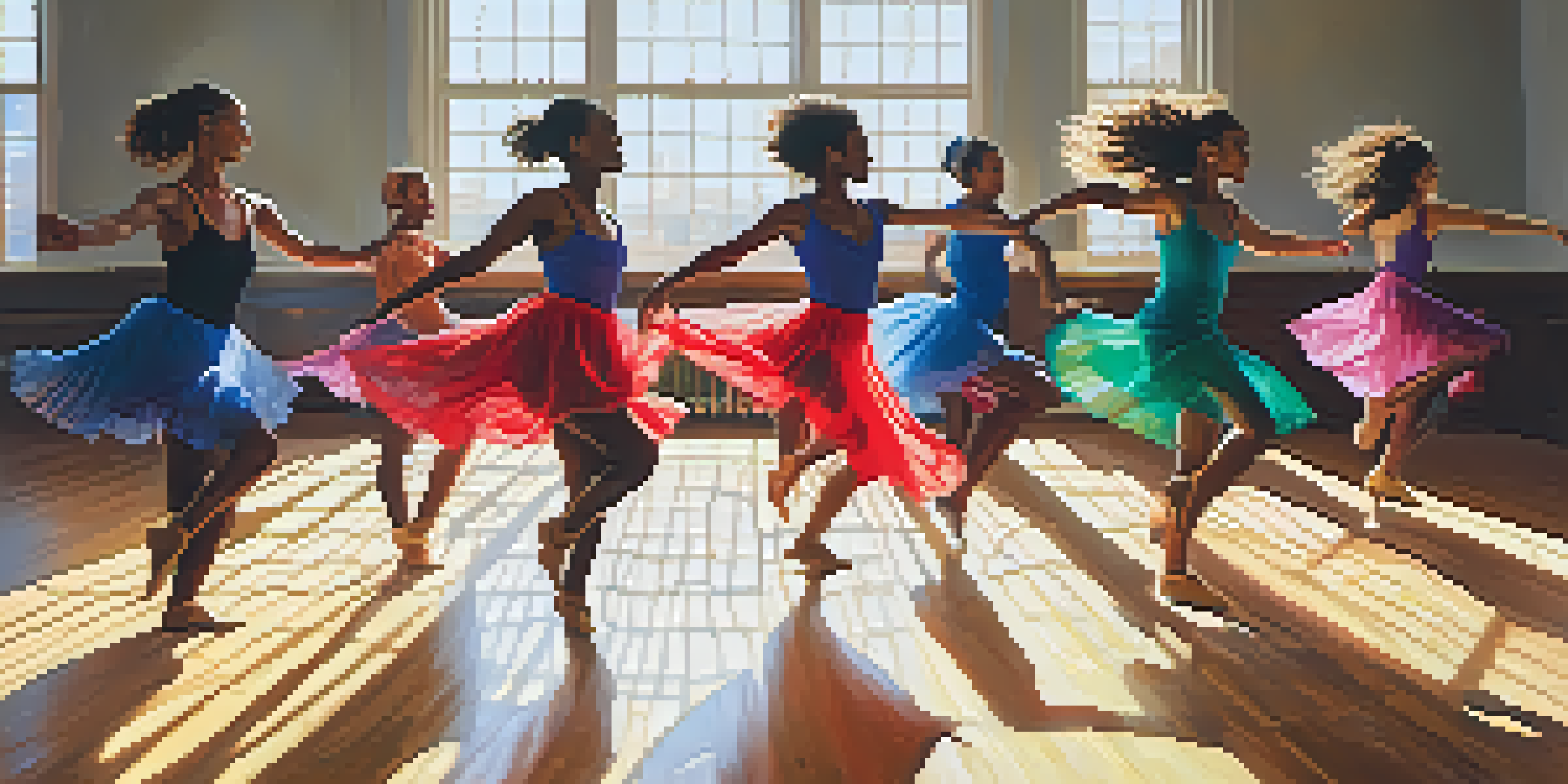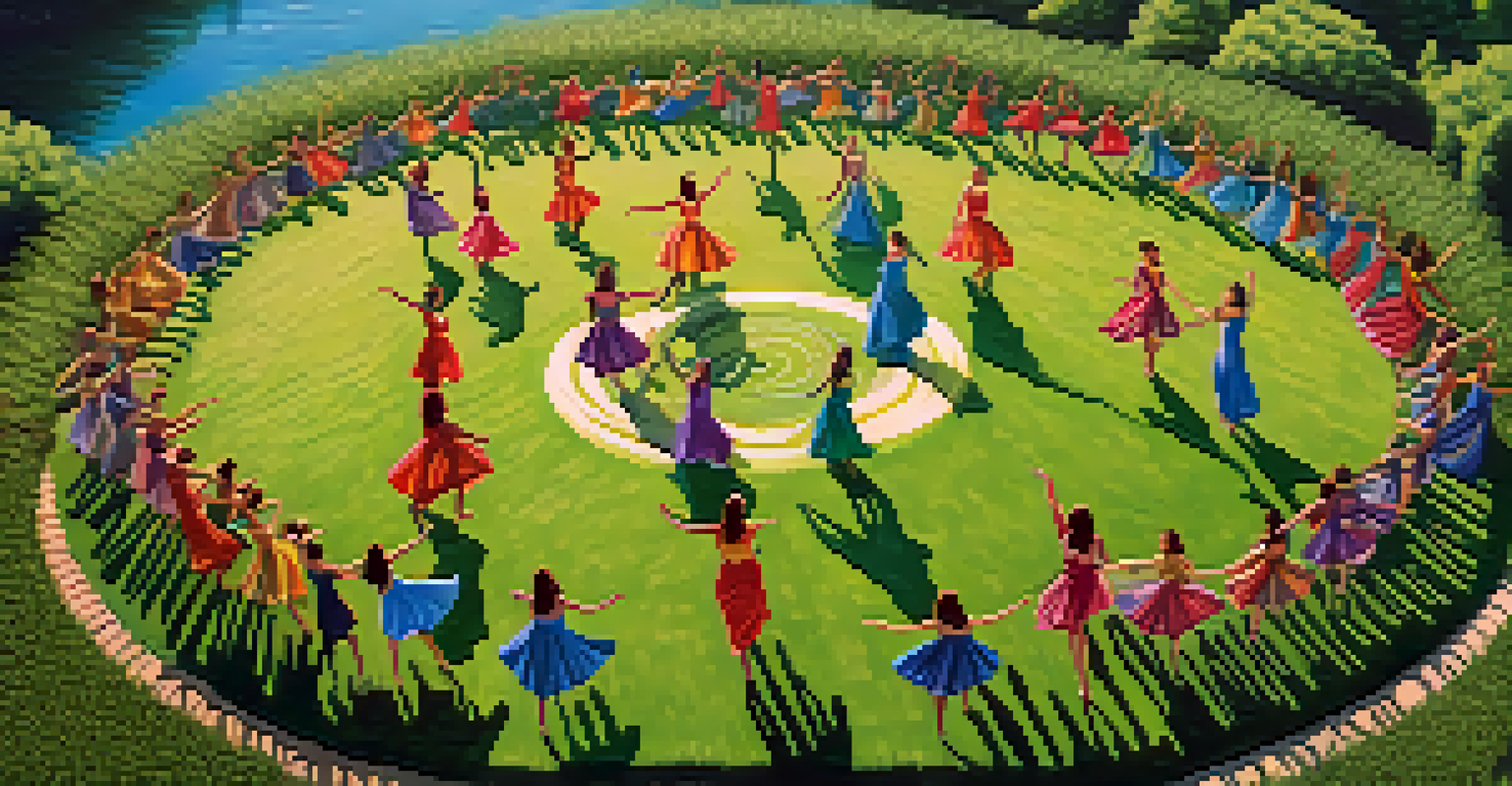The Impact of Improvisational Techniques on Dance Performances

Understanding Improvisation in Dance
Improvisation in dance refers to the spontaneous creation of movement without choreography. Dancers rely on their intuition and body awareness, allowing them to explore new expressions and styles. This technique can range from free-form movement to structured improvisational exercises, making it versatile for various dance genres.
Dance is the hidden language of the soul.
At its core, improvisation encourages dancers to listen to their bodies and the music, fostering an organic connection to the performance. This connection can lead to unexpected moments of beauty that resonate with audiences. Think of improvisation as a conversation between the dancer and the music, where each note inspires a unique response.
Moreover, improvisation breaks down the barriers of rigid choreography, offering dancers the freedom to experiment and innovate. This flexibility can lead to the emergence of new dance forms and styles, enriching the overall dance landscape. By embracing improvisation, dancers can discover their authentic selves and express their creativity in fresh ways.
Enhancing Creativity Through Improvisation
Improvisational techniques serve as a powerful catalyst for creativity in dance. When dancers step into the realm of improvisation, they allow their minds to wander, leading to unexpected and innovative movements. This process not only enhances their repertoire but also fosters a playful approach to dance.

For instance, consider a dancer who starts with a simple step and allows their body to react to the rhythm. This can lead to a series of movements that might never have been choreographed. By nurturing this creative exploration, dancers can develop an authentic voice in their performances.
Improvisation Enhances Creativity
Dancers can unlock innovative movements and develop their authentic voice by exploring improvisational techniques.
Additionally, improvisation helps dancers build confidence in their abilities. When they experiment with movement, they learn to trust their instincts and embrace their individuality. This newfound confidence often translates into more dynamic and engaging performances, captivating audiences in ways that scripted routines may not.
Building Connection with the Audience
One of the most significant impacts of improvisational techniques is the connection established with the audience. When dancers improvise, they often embody raw emotion, making performances feel more personal and relatable. This emotional authenticity can create a powerful bond with viewers, drawing them into the dancer's world.
Improvisation is the ability to create something from nothing.
Imagine watching a dancer who, in the midst of a performance, seems to be communicating directly with the audience through their movements. This interactive experience can evoke a range of emotions, from joy to nostalgia, making the performance unforgettable. Audiences appreciate the spontaneity of improvisation, as it brings an element of unpredictability to the show.
Moreover, improvisation encourages a two-way interaction between the performer and the audience. Dancers may respond to the audience's energy, adjusting their movements to enhance the overall experience. This dynamic relationship cultivates a sense of community, turning a solo performance into a shared experience.
Cultivating Presence and Mindfulness
Improvisational dance fosters a sense of presence and mindfulness among performers. Dancers must remain fully attuned to their bodies and the surrounding environment, cultivating a heightened awareness that can enhance their overall performance. This presence allows them to respond instinctively to the music and their own movement.
For example, during an improvisational session, a dancer might become acutely aware of how their body interacts with the space around them. This awareness can lead to fascinating discoveries about movement and flow. By being present, dancers can break free from distractions and immerse themselves fully in the creative process.
Fosters Audience Connection
Improvisation allows dancers to connect emotionally with audiences, creating a shared and memorable experience.
Furthermore, this mindfulness extends beyond the dance studio, positively impacting dancers' personal lives. The skills learned through improvisation can help individuals manage stress and improve focus, leading to a more balanced and fulfilling approach to both dance and life.
Developing Collaborative Skills in Dance
Improvisational techniques also enhance collaboration among dancers. When improvising in groups, dancers must communicate and respond to each other's movements in real-time. This interaction fosters a sense of teamwork, as each dancer plays a vital role in shaping the performance together.
Picture a group of dancers moving in sync, each responding to the others' movements while adding their unique flair. This collaboration not only enriches the performance but also strengthens the bonds between dancers. The shared experience of improvisation can lead to lasting friendships and a supportive dance community.
Moreover, collaborative improvisation encourages dancers to step out of their comfort zones. They learn to trust their peers and take risks, which can result in innovative choreography that reflects the collective creativity of the group. This teamwork can elevate a performance, showcasing the beauty of unity in diversity.
Adapting Improvisation for Different Dance Styles
Improvisational techniques can be adapted to suit various dance styles, from ballet to hip-hop. Each genre has its unique characteristics, allowing for creative interpretations of improvisation. For instance, a ballet dancer might incorporate fluid movements, while a hip-hop dancer might focus on sharp, rhythmic expressions.
In modern dance, improvisation often serves as a foundation for choreography, with dancers exploring themes and emotions that can later be refined. This blend of improvisation and structured movement creates a dynamic performance that captivates audiences. The adaptability of improvisation means it can thrive in any dance context.
Adapts Across Dance Styles
Improvisational techniques can be tailored to various dance genres, enriching performances and expanding artistic versatility.
Furthermore, workshops and classes often incorporate improvisational exercises to help dancers unlock their potential, regardless of their style. By exploring different approaches to improvisation, dancers can enhance their versatility and expand their artistic horizons, making them more well-rounded performers.
The Future of Improvisation in Dance
As the dance world continues to evolve, the role of improvisation is becoming increasingly significant. Contemporary dance often embraces improvisation as a core component, reflecting modern society's values of spontaneity and authenticity. This trend suggests a shift towards a more inclusive approach to dance.
With the rise of technology and social media, dancers are now exposed to a plethora of styles and influences, encouraging them to experiment with improvisation. This cross-pollination of ideas can lead to exciting new forms of dance, breaking traditional boundaries and redefining what dance can be. The future of dance is likely to be a vibrant tapestry woven from diverse influences and spontaneous creativity.

Moreover, as audiences seek more authentic experiences, the demand for improvisational performances will likely increase. Dancers who embrace this technique will not only stand out but also connect more deeply with their viewers. As we look ahead, improvisation promises to remain a vital and transformative force in the dance community.